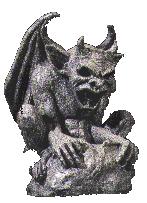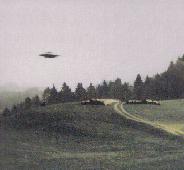
PARANORMAL SITES
As we observed countdown 2000 did you notice
the resurgence of the supernatural
in everyday life? Consider the following:
- Best-selling books include Hal Lindsey's apocalyptic The Late Great
Planet Earth, Raymond Moody's Life After Life (1975), and Betty Eadie's
Embraced By the Light (1992). The nation's top paperback publisher, Bantam
Books, increased its number of New Age-type books by ten-fold between the
late 1970s and late 1980s, and became the company's fastest growing line
of non-fiction books.
- As Americans were spending hundreds of dollars per hour to psychics
to "channeling" advice from alleged spiritual entities, Psychic
Networks appeared on cable television.
- Years after his 1977 death, reported sightings of rock-icon Elvis
Presley continue to be "news"--so numerous, in fact, that they
became the source of parody.
- The spiritual genre of popular movies grossed hundreds of millions
of dollars, with such blockbusters as the "Star Wars" trilogy,
"Ghost," and "Sixth Sense." In the 1990s, religious and
spiritual books are entering the best-seller book lists, attracting major
publishing houses. Barnes & Noble increased the number of its religious
titles by 35 percent between 1993 and 1995 (Tabor, 1995).
- A 1994 U.S. News and World Report survey (n=1,000) revealed that
nearly six in 10 Americans believe the world will come to an end or be
destroyed (a third of whom thinking it will happen within a few years or
decades), with 61 percent believing Jesus Christ will return, and 44 percent
expecting a final battle of Armageddon (Sheler, 1994).
- Results of a 1994 USA Today/CNN/Gallup survey revealed 90%
of Americans believing in heaven, 72% believing in angels, and 65% believing
in the Devil.
- Occultopedia An Encyclopedia of Occult Sciences and Knowledge
- The WWW Virtual Library:
Archive X, Paranormal Phenomena
- The Mysterious
&
Unexplained
- Hope's Metaphysical
Mindscape
- Nostradamus
- Psi Explorer: Premonitions,
ESP, psychic healing, mind or matter ...
UFOs: WHEN CRACKS APPEAR IN THE
SACRED CANOPY
AND THE UFO's ARE LET IN
 As the Soviet Union became embroiled with internal dissention with
glasnost triggering nationalist sentiments and critical reflections
on the past, curious reports trickled in from Voronezh of four-meter- tall
aliens with small heads landing in the city's park. In 1952, in the midst
of McCarthyism, numerous UFOs were reported (and photographed) over the
White House. Might there be some connection between a country being in
the midst of moral upheaval, suffering crises of legitimation, and such
sightings?
As the Soviet Union became embroiled with internal dissention with
glasnost triggering nationalist sentiments and critical reflections
on the past, curious reports trickled in from Voronezh of four-meter- tall
aliens with small heads landing in the city's park. In 1952, in the midst
of McCarthyism, numerous UFOs were reported (and photographed) over the
White House. Might there be some connection between a country being in
the midst of moral upheaval, suffering crises of legitimation, and such
sightings?
Click here to see the numbers of UFO stories
reported in the New York Times and in the Reader's Periodical
Guide between 1947 and 1988. (Thanks to Dawn Teel for this inventorying.
Through 1958 the index category was "flying saucer," after which
it became "UFO.") Evident are a high correspondence between these
two sources and a longitudinal pattern far from being uniform, with peaks
in the early 1950s, mid 1960s and late 1970s.
At the risk of running into some historicist
error, at least the first two of these peaks correspond to acknowledged
times of moral uncertainty in the United States, the post-war period of
McCarthyism and the time of dramatically increasing U.S. involvement in Vietnam.
The late-1970s peak is less clear.
Another hypothesis is that these times of moral uncertainty correspond with
periods of heightened Cold War tensions. The damper in 1997 for UFO enthusiasts celebrating
the fiftieth anniversary of the much-hyped Roswell crash was the declassification and release of
the "CIA's Role in the
Study of UFOs, 1947-90". Your government at work: fan the beliefs in
extraterrestrials to cover-up the existence of new secret spy craft. To
see what the government might really be up to, check out the Black
Vault archives, which include UFO
files (over 4000 pages) released under the Freedom of Information Act.
GHOSTS AND SPIRITUAL ENTITIES
 Sir James George Frazer (Man, God, and Immortality: Thoughts on Human
Progress, Cambridge: Trinity College Press, 1968) argued that the belief in the existence
of apparitions of deceased persons are but manifestations of humanity's belief in the
immortality of the human soul. This belief has, he wrote, "led race after race, generation after
generation, to sacrifice the real wants of the living to the imaginary wants of the dead"
(1968:380). Interestingly, as Americans' belief in an afterlife
have increased over the past two decades (from 77 to 82 percent, according to the
NORC General Social Surveys), the ghost theme seems to have become an increasingly
popular movie genre, evidenced by such films as "High Spirits," "Field of Dreams," "All
Dogs Go to Heaven," "Always," "Ghost," and "Ghost Dad." Instead of the living sacrificing
for the needs of the dead, in these we find ghosts generally coming to the aid of their loved
ones.
Sir James George Frazer (Man, God, and Immortality: Thoughts on Human
Progress, Cambridge: Trinity College Press, 1968) argued that the belief in the existence
of apparitions of deceased persons are but manifestations of humanity's belief in the
immortality of the human soul. This belief has, he wrote, "led race after race, generation after
generation, to sacrifice the real wants of the living to the imaginary wants of the dead"
(1968:380). Interestingly, as Americans' belief in an afterlife
have increased over the past two decades (from 77 to 82 percent, according to the
NORC General Social Surveys), the ghost theme seems to have become an increasingly
popular movie genre, evidenced by such films as "High Spirits," "Field of Dreams," "All
Dogs Go to Heaven," "Always," "Ghost," and "Ghost Dad." Instead of the living sacrificing
for the needs of the dead, in these we find ghosts generally coming to the aid of their loved
ones.
- Any haunted places in your community? Check out Shadowland's Haunted Places Index
- Dagulf's Ghost
- Paranormal Investigations of Texas
- South Texas Ghost Hunters Alliance
- Ghost Research Society
- Yahoo's collection of ghost sites
- Ghosts of the Prairie: The
Travel Guide to America's Haunted and Mysterious Places
- The Ghost
Hunters Gallery
Before making any assumptions of truth to the stories and accounts that you read
above, be sure to check out Robert T. Carroll's "The Skeptic's
Dictionary: A Guide for the New Millennium".
OTHER STRANGE PLACES
- The Bermuda Triangle

 Return to A Sociological Tour Through
Cyberspace
Return to A Sociological Tour Through
Cyberspace
 Sir James George Frazer (Man, God, and Immortality: Thoughts on Human
Progress, Cambridge: Trinity College Press, 1968) argued that the belief in the existence
of apparitions of deceased persons are but manifestations of humanity's belief in the
immortality of the human soul. This belief has, he wrote, "led race after race, generation after
generation, to sacrifice the real wants of the living to the imaginary wants of the dead"
(1968:380). Interestingly, as Americans' belief in an afterlife
have increased over the past two decades (from 77 to 82 percent, according to the
NORC General Social Surveys), the ghost theme seems to have become an increasingly
popular movie genre, evidenced by such films as "High Spirits," "Field of Dreams," "All
Dogs Go to Heaven," "Always," "Ghost," and "Ghost Dad." Instead of the living sacrificing
for the needs of the dead, in these we find ghosts generally coming to the aid of their loved
ones.
Sir James George Frazer (Man, God, and Immortality: Thoughts on Human
Progress, Cambridge: Trinity College Press, 1968) argued that the belief in the existence
of apparitions of deceased persons are but manifestations of humanity's belief in the
immortality of the human soul. This belief has, he wrote, "led race after race, generation after
generation, to sacrifice the real wants of the living to the imaginary wants of the dead"
(1968:380). Interestingly, as Americans' belief in an afterlife
have increased over the past two decades (from 77 to 82 percent, according to the
NORC General Social Surveys), the ghost theme seems to have become an increasingly
popular movie genre, evidenced by such films as "High Spirits," "Field of Dreams," "All
Dogs Go to Heaven," "Always," "Ghost," and "Ghost Dad." Instead of the living sacrificing
for the needs of the dead, in these we find ghosts generally coming to the aid of their loved
ones. 
 As the Soviet Union became embroiled with internal dissention with
glasnost triggering nationalist sentiments and critical reflections
on the past, curious reports trickled in from Voronezh of four-meter- tall
aliens with small heads landing in the city's park. In 1952, in the midst
of McCarthyism, numerous UFOs were reported (and photographed) over the
White House. Might there be some connection between a country being in
the midst of moral upheaval, suffering crises of legitimation, and such
sightings?
As the Soviet Union became embroiled with internal dissention with
glasnost triggering nationalist sentiments and critical reflections
on the past, curious reports trickled in from Voronezh of four-meter- tall
aliens with small heads landing in the city's park. In 1952, in the midst
of McCarthyism, numerous UFOs were reported (and photographed) over the
White House. Might there be some connection between a country being in
the midst of moral upheaval, suffering crises of legitimation, and such
sightings?
